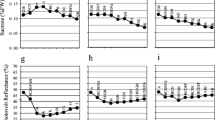Abstract
Three potato cultivars (Russet Burbank, Norchip, and Gemchip) grown with nitrogen applied at three rates were stored at two temperature regimes (Treatment 1: 13 months at 10 CTreatment 2: 1 month at 10 C; followed by a 1 C decrease per week until tubers were 4 C; followed by 6 months at 4 C; followed by a 1 C increase per week until tubers were 10 C; followed by 3 months at 10 C). Tuber chemical components and potato chip appearance were measured at harvest and after 3, 6, 9, 11, 12, and 13 months; these measurements were performed within 24 hours of the time potatoes were removed from storage. Sugar responses (tuber glucose, fructose, sucrose) and potato chip appearance were affected by cultivar over time in both years and storage temperatures. Russet Burbank tubers displayed a significantly higher glucose forming potential and produced darker appearing chips, regardless of storage temperature or time in storage, compared to Norchip and Gemchip. Potatoes receiving a cold-storage treatment contained less sugar and produced lighter appearing chips after 12 months storage compared to tubers stored at a constant 10 C for 12 months. The linear association between tuber chemical components and potato chip appearance varied with storage temperature.
Similar content being viewed by others
Literature Cited
Bradford, N. M. 1976. A rapid and sensitive method for the quantification of microgram quan tities of protein using the principle of protein dye binding. Anal Biochem 72:248–254.
Bredemeijer, G. M. M., H. C. J. Burg, P. A. M. Claassen, and W. J. Stiekema. 1991. Phosphofruc tokinase in relation to sugar accumulation in cold-stored potato tubers. J Plant Physiol 138:129–135.
Burton, W. G. 1989. The Potato, Ed. 3. Longman Scientific and Technical, Essex. pp. 432–434.
Caper, A. C., S. L. Desborough, and P. H. Li. 1975. Extraction of non-protein nitrogen from potato tuber and its amino acid composition. Potato Res 18:582–587.
Cobb, A. H., P. C. M. Hart, and R. M. J. Storey. 1990. The role of reducing sugars and amino acids in the processing quality of Pentland Dell Tubers stored at 5 and 10 C. Proceedings of the 11th Triennial Conference of the European Association for Potato Research pp.284- 285.
Desborough, S. and C. J. Weiser. 1974. Improving potato protein. I. Evaluation of selection techniques. Am Potato J 51:185–196.
Dwelle, R. B. and G. F. Stallknecht. 1978. Pentose phosphate metabolism of potato tuber discs as influenced by prior storage temperature. Plant Physiol 61:252–253.
Habib, A. T. and H. D. Brown. 1957. Role of reducing sugars and amino acids in the browning of potato chips. Food Technology, Feb:85-89.
Hammond, J., M. M. Burrell, and N. J. Kruger. 1990. Effect of low temperature on the activity of phosphofructokinase from potato tubers. Planta 180:613–616.
Hans, A. C. 1970. The determination of total organic nitrogen.In: Methods of Food Science. Academic Press pp. 601–609.
Herrman, T. J., B. Shafii, S. L. Love, and R. B. Dwelle. 1995. Influence of crop management fac tors on chipping potato maturity and storage processing performance. J Sci Food Agric 68:51–58.
Hoover, E. F. and P. A. Xander. 1963. Influence of specific compositional factors of potatoes on chipping color. Am Potato J 40:17–24.
Iritani, W. M. and R. E. Thornton. 1984. Potatoes: influencing seed tuber behavior. Pacific Northwest Extension Publication No. 248. Pullman, WA.
Isherwood, F. A. 1976. Mechanism of starch-sugar interconversion inSolanum tuberosum. Phyto chemistry 15:33–41.
Leszkowiat, M. J., V. Barichello, R. Y. Yada, R. H. Coffin, E. C. Lougheed, and D. W. Stanley. 1990. Contribution of sucrose to nonenzymatic browning in potato chips. J Food Sci 55:281–282.
Marquez, G. and M. C. Anon. 1986. Influence of reducing sugars and amino acids in the color development of fried potatoes. J Food Sci 51:157–160.
Mazliak, P. 1987. Membrane changes and consequences for the postharvest period.In: J. Weichmann, ed. Postharvest Physiology of Vegetables. Dekker, New York, pp 95–111.
Pressey, R. 1969. Role of invertase in the accumulation of sugars in cold-stored potatoes. Am Potato J 46:291–291.
SAS Institute. 1989. SAS Stat Users’ Guide, Version 6. Ed. SAS Inst. Inc., Cary, N. C.
Schwimmer, S. C., E. Hendel, W. O Harrington, and R. L. Olson. 1957. Interrelation among measurements of browning of processed potatoes and sugar components. Am Potato J 34:119–132.
Shekhar, V. C., W. M. Iritani, and J. Magnuson. 1979. Starch-sugar interconversion inSolanum tuberosum L. II. Influence of membrane permeability and fluidity. Am Potato J 56:225–235.
Sowokinos, J. R. 1978. Relationship of harvest sucrose content to processing maturity and storage life of potatoes. Am Potato J 55:333–344.
Sowokinos, J. R., P. H. Orr, J. A. Knoper, and J. L. Varns. 1987. Influence of potato storage and handling stress on sugars, chip quality and integrity of the starch (amyloplast) membrane. Am Potato J 64:213–226.
Sowokinos, J., B. Morgan, M. Sleeper, and I. Shea. 1989. Glucose-forming-potential (GFP): A tool to screen for superior processing potato clones. Am Potato J 66:545.
Spychalla, J. P. and S. L. Desborough. 1990. Fatty acids, membrane permeability, and sugars of stored potato tubers. Plant Physiol 94:1207–1213.
Trevanion, S. J. and N. J. Kruger. 1991. Effect of temperature on the kinetic properties of pyrophosphate: fructose 6-phosphate phosphotransferase from potato tuber. J Plant Physiol 137:753–759.
Author information
Authors and Affiliations
Rights and permissions
About this article
Cite this article
Herrman, T.J., Love, S.L., Shafii, B. et al. Chipping performance of three processing potato cultivars during long-term storage at two temperature regimes. American Potato Journal 73, 411–425 (1996). https://doi.org/10.1007/BF02849514
Accepted:
Issue Date:
DOI: https://doi.org/10.1007/BF02849514




